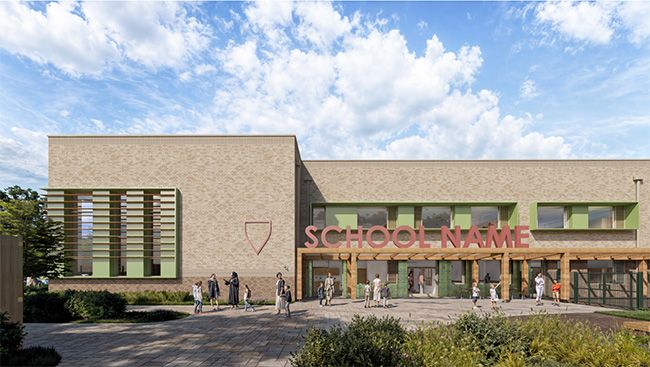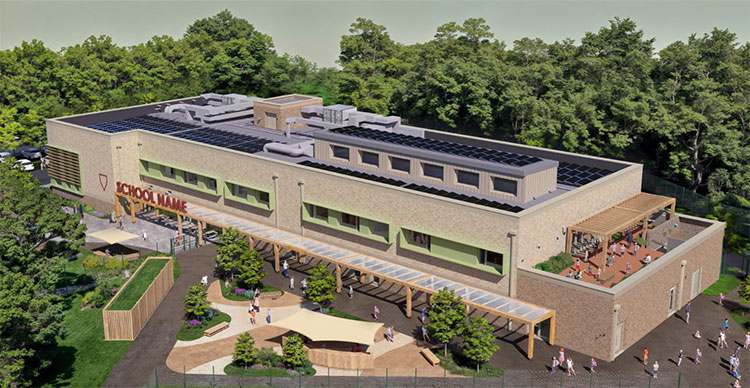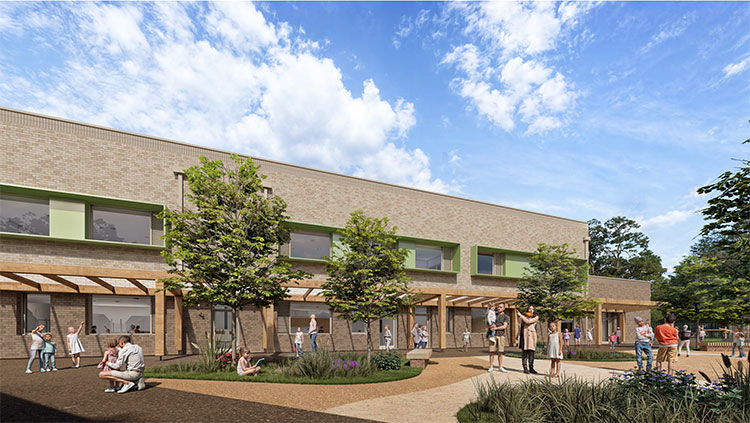The project is supported by funding from the Welsh Government’s
Sustainable Schools Challenge, an initiative that aims to deliver three new schools across Wales in Rhondda Cynon Taf, Neath Port Talbot and Gwynedd that embody environmental sustainability and stakeholder engagement throughout all stages of the design, build and operation. The new school for Glyn-coch will prioritise the wellbeing of pupils, staff, and the Glyn-coch community.
The new school will be able to accommodate all pupils currently attending Cefn and Craig-Yr-Hesg primary schools and will have capacity for 300 pupils (aged 4-11), plus nursery and two learning support classes. There will also be dedicated community facilities and a Welsh medium childcare provision within the new school building to create an educational, community and wellbeing hub.

The Council’s vision for the project is:
‘To create an educational, community and wellbeing hub which unifies Glyn-coch, meets local needs, and fulfils the aspirations of learners and the community.’
Guided by the community
We have established a Community Stakeholder Forum as part of our collaborative approach to the building design. The Forum is integral to our design approach for the proposed community facilities and will complement engagement activities with the existing schools, including learners.
"We need a building that reflects our aspirations" Sarah Haggett – Executive Head, The Fern Federation
For the younger generation, the school will provide much-needed sport, social, and educational facilities, including new Multi Use Games Areas (MUGAs), a woodland learning zone and a brand-new football pitch on the existing site of Craig-Yr-Hesg Primary School.
There is also an opportunity to host discreet support services within the community facilities, the exact nature of which will be determined based on local needs identified through collaboration with the Community Forum.
Connecting the school with nature
Recognising the nature emergency declared by the Welsh Government, the school will achieve Biodiversity Net Gain and will obtain Building with Nature accreditation.

In order to integrate nature into the design, the woodland to the north of the new school will be extended into the site with woodland and pond learning zones to create opportunities for pupils to connect with nature, while the emphasis on biophilic design throughout the school building is in line with the aims of the Sustainable Schools Challenge.
The landscape strategy provides outdoor teaching areas around the site, including multiple outdoor classroom areas, one of which is at first floor level to provide older pupils with access to nature. For the community, there will be a growing and wellbeing garden to offer a space for quiet reflection and to create opportunities to encourage healthy eating.

The interior design will complement the wider themes of the project. The use of natural materials such as timber will contribute towards a calming internal environment within the school.
Active travel
Active travel will be prioritised on the new school site. A new pedestrian entrance will be created in the north-western corner of the site to encourage those living to the north of the site to walk to school. Sheltered areas are also provided to the north and south of the school building for parents arriving on foot during pick up and drop off periods.
To support those cycling or scooting to school, 49 cycle / scooter parking spaces are included, along with a buggy store for parents / carers dropping off children at the childcare facility on foot. All cycle / buggy storage areas are enclosed structures and include a ‘green roof’ to further support climate resilience.

Climate resilience
All new school buildings in Wales must minimise the amount of carbon produced during construction and achieve Net Zero Carbon in operation, meaning they offset more carbon than they produce once the school is in use.
The new school for Glyn-coch will achieve Net Zero Carbon in operation. Further, when the new school opens in 2026, it will achieve the Welsh Government’s 2030 embodied carbon target for new school projects. A key feature that will help achieve this ambitious target is the new school’s timber frame, which will be built using timber grown here in the UK. By using home grown instead of imported timber, we will support the growing UK timber industry.
Building for wellbeing
The new school for Glyn-coch is targeting being the first school in Wales to achieve WELL Building Standard Version 2 (WELL V2) accreditation.
The WELL V2 standard focuses on how a building can deliver healthy environments for people through 10 key concepts that facilitate wellness, including building materials, nourishment, light, community, air and water quality.
The new school building will also be constructed to the Passivhaus design standard, which aims to optimise energy performance and thermal comfort for building users, providing further wellbeing benefits.
A pathfinder project for Welsh school design
In line with the Wellbeing of Future Generations Act, the new school for Glyn-coch will have an impact that goes beyond the typical mandate for primary schools, at a time when so many people are struggling with their physical and mental health. The project can act as a pathfinder for education design in Wales and will form part of a case study alongside other Sustainable Schools Challenge projects, with the aim of providing inspiration for the future of the Welsh Government’s Sustainable Communities for Learning Programme.